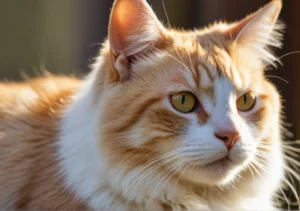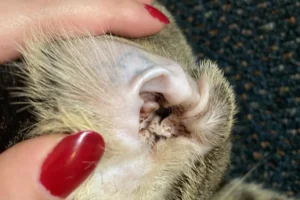Cats are known for their mysterious and sometimes quirky behaviors. If you’ve noticed your cat’s ears vibrating, you might be wondering what could be causing this interesting phenomenon.
Understanding the Physiology of Cat Ears
Let’s take a closer look at the fascinating anatomy of a cat’s ears. Those adorable flaps serve multiple functions beyond just hearing. Cats’ ears have around 32 muscles, allowing them to rotate each ear independently to pick up even the slightest sound. Their inner ears play a crucial role in maintaining balance, especially during those acrobatic jumps and leaps.
The middle ear contains three tiny bones that transmit sound vibrations to the inner ear. Moreover, cats have a unique structure called the vestibular system, which helps them stay oriented and balanced. So, the next time you admire your furry friend’s ears, remember they are not just for show – they are finely-tuned instruments designed to keep your cat agile and alert.
Common Reasons for Ear Vibrations in Cats
Have you ever noticed your cat’s ears vibrating mysteriously, almost as if they’re sending out secret signals? Well, fear not, as there are some common reasons behind this curious behavior. One of the most usual culprits for ear vibrations in cats is excitement. When your cat is thrilled or curious about something, their ears might quiver with anticipation.
Another possible explanation is fear. If your cat feels threatened or scared, their ears may vibrate involuntarily as their body goes into fight-or-flight mode. However, if you notice persistent or excessive ear vibrations, it could be a sign of an underlying medical condition that requires attention from a veterinarian. So, keep an eye on those vibrating ears and ensure your feline friend stays healthy and happy.
Stress and Anxiety Indicators
If you notice your cat’s ears vibrating, it could be a sign of stress or anxiety. Cats may exhibit this behavior when they are feeling overwhelmed or fearful. Pay attention to other cues like flattened ears, dilated pupils, or a tense body posture to determine if your feline friend is feeling uneasy. Providing a safe and quiet space for your cat to retreat to can help alleviate their stress and reduce the vibrations in their ears.
Physical Health Concerns
When it comes to your cat’s ears vibrating, it’s essential to consider potential health issues that could be at play. Ear infections, neurological problems, or even parasites like ear mites can cause your cat’s ears to tremble. If you notice excessive ear vibrations or other concerning symptoms like head shaking, pawing at the ears, or discharge, it’s crucial to have your furry companion examined by a veterinarian. Proper diagnosis and treatment can help resolve the underlying health issue and alleviate your cat’s discomfort.
Signs of Ear Infections:
- Scratching or rubbing the ears frequently.
- Unpleasant odor coming from the ears.
- Redness or swelling in the ear canal.
- Discharge or debris in the ears.
Remember, your cat’s well-being is a top priority, so don’t hesitate to seek professional guidance if you have concerns about their ear vibrations.
The Role of Grooming and Cleaning
When your cat’s ears are vibrating, it could be a sign that they are diligently grooming themselves. Cats are meticulous groomers, using their tongues to clean their fur from head to tail. During this grooming process, they also pay close attention to their ears, licking and nibbling to keep them clean. The vibration you see or feel could be a result of this thorough grooming routine.
Additionally, cats have scent glands in their ears that they use to mark their territory. Through grooming, they distribute their scent throughout their fur and ears, signaling to other animals that this is their space. This behavior is instinctual and helps your cat feel secure in their environment.
Regularly cleaning your cat’s ears is essential to maintaining their overall health and preventing issues such as ear infections. Make sure to use a gentle ear cleaning solution specifically designed for cats and consult with your veterinarian if you notice any abnormalities or persistent vibrations in your cat’s ears.
Environmental Factors
The vibrations in your cat’s ears can also be influenced by their environment. Cats are highly sensitive animals and can easily become stressed by changes in their surroundings or interactions with other pets or people. If your cat is experiencing increased vibrations in their ears, it could be a sign of heightened anxiety or discomfort.
To help reduce stress and potential ear vibrations, create a calm and predictable environment for your cat. Provide them with a quiet space where they can retreat when feeling overwhelmed and ensure they have access to their essential resources like food, water, and a litter box.
Furthermore, consider the interactions your cat has with other pets or people in the household. If there are any conflicts or tension between animals or individuals, this could be contributing to your cat’s ear vibrations. Encourage positive interactions and provide ample opportunities for your cat to feel safe and secure in their home environment.
Remember, maintaining a harmonious and stress-free environment is crucial for your cat’s overall well-being and can help alleviate any potential ear vibrations they may be experiencing.
Behavioral Triggers
Have you ever noticed your cat’s ears vibrating and wondered what might be causing it? Well, one common reason for this could be behavioral triggers. Cats have incredibly sensitive hearing, so loud noises or sudden movements can lead to their ears vibrating in response. This heightened sensitivity is a natural defense mechanism that helps cats stay alert and aware of their surroundings. So, if your cat’s ears are vibrating, consider if there have been any loud noises or sudden movements in the vicinity that could be triggering this reaction.
Seeking Veterinary Advice
If you observe your cat’s ears vibrating frequently and persistently, it’s crucial to seek veterinary advice. While occasional ear vibrations may not be a cause for concern, persistent or concerning ear vibrations could be a sign of an underlying health issue that requires professional attention. A vet will be able to examine your cat thoroughly, diagnose any potential problems, and provide the necessary treatment or guidance. Remember, your cat’s health and well-being should always come first, so don’t hesitate to consult a vet if you have any doubts or concerns about your furry friend’s ear vibrations.
Extra Insight: Regular ear check-ups
Apart from seeking veterinary advice when you notice unusual ear vibrations, it’s also a good idea to schedule regular ear check-ups for your cat. Just like humans, cats can develop ear-related issues that may not always be visibly apparent. By including ear examinations in your cat’s routine veterinary care, you can help prevent potential problems and ensure your cat’s ears stay healthy and happy.
Why are my cat’s ears vibrating?
If you’ve noticed your cat’s ears vibrating, don’t worry, it’s perfectly normal and usually a sign of something interesting happening. Cats have an incredible sense of hearing, and their ears can move independently to pick up sounds from different directions. When your cat’s ears are vibrating, it could be because they are focusing on a particular sound or trying to pinpoint the exact location of a noise.
This rapid movement of the ears helps cats enhance their hearing accuracy and sensitivity, allowing them to detect prey or potential threats even from a distance. So, the next time you see your cat’s ears vibrating, know that they are just utilizing their superpower of exceptional hearing!
Fun Facts About Cat Ears
Did you know that a cat’s ears have up to 32 muscles, enabling them to rotate their ears 180 degrees and move them independently? This incredible ability helps cats locate the source of a sound quickly and accurately. Additionally, cats can hear frequencies as high as 65 kHz, far beyond human capability.
- Cats use their ears not only for hearing but also to express their emotions. Ears held forward show interest or curiosity, while flattened ears indicate fear or aggression.
- The tufts of hair on some cat breeds’ ears are called “ear furnishings” and are believed to protect the ears from debris and enhance their hearing.
Next time you observe your feline friend’s ears vibrating or twitching, remember it’s just a manifestation of their remarkable auditory prowess in action.
Alex, a passionate animal lover, has experience in training and understanding animal behavior. As a proud pet parent to two dogs and three cats, he founded AnimalReport.net to share insights from animal experts and expand his knowledge of the animal kingdom.




